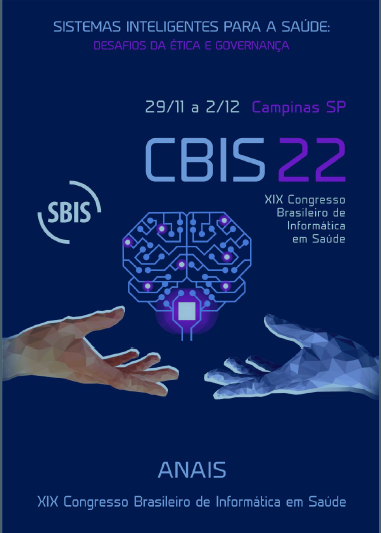A longitudinal study of motor training using augmented reality
DOI:
https://doi.org/10.59681/2175-4411.v15.iEspecial.2023.1088Keywords:
Augmented Reality, Magnetic Resonance Imaging, StrokeAbstract
Objective: To present an augmented reality system's architecture and training protocol, designed to provide visual stimuli for shoulder exercises. Methods: A low-cost mixed reality system was developed to provide motor imagery through a three-dimensional virtual arm that replaces the image of the user's real arm in the mirror image on the computer screen. A protocol was proposed, and three participants with chronic stroke with different left hemiparesis levels participating the system's longitudinal study. Range of motion measurements was obtained at the beginning and end of each session. Results: Changes in participants' range of motion with mild and medium-level hemiparesis were observed. The participant's range of motion with total (severe) paralysis did not change. Conclusion: The augmented reality system is suitable for participants with different levels of upper limb paralysis.
References
Whitehead S, Baalbergen E. Post-stroke rehabilitation. S Afr Med J. 2019 Jan 31;109(2):81.
Riz G, Bruno TE, Miura DY, Barra CMCM, Santos EAP, Moro CHC, Safanelli J. Análise do Engajamento de Pacientes com AVC Isquêmico Utilizando Mineração de Processos. J. Health Inform. 2020 Dezembro; 12:307-12.
Tsoupikova D, Stoykov NS, Corrigan M, Thielbar K, Vick R, Li Y, et al. Virtual Immersion for Post-Stroke Hand Rehabilitation Therapy. Annals of Biomedical Engineering. 2015 Jan 6;43(2):467–77.
Magna TS, Brandão AF, Fernandes PT. Intervenção por realidade virtual e exercício físico em idosos. J. Health Inform. 2020 Julho-Setembro; 12(3):77-82.
Feitosa JA, Fernandes CA, Casseb RF, Castellano G. Effects of virtual reality-based motor rehabilitation: a systematic review of fMRI studies. J Neural Eng. 2022 Jan 24;19(1). doi: 10.1088/1741-2552/ac456e. PMID: 34933281.
Campos Filho AS, Lemos WB, Souza RC, Lima LLB. Realidade virtual como ferramenta educacional e assistencial na saúde: uma revisão integrativa. J. Health Inform. 2020 Abril-Junho; 12(2):58-63.
Peters TM. Overview of Mixed and Augmented Reality in Medicine. Mixed and Augmented Reality in Medicine. 2018 Oct 26;1–13.
Escalada-Hernández P, Soto Ruiz N, San Martín-Rodríguez L. Design and evaluation of a prototype of augmented reality applied to medical devices. International Journal of Medical Informatics. 2019 Aug;128:87–92.
John B, Wickramasinghe N. A Review of Mixed Reality in Health Care. Healthcare Delivery in the Information Age. 2019 Nov 28;375–82.
Assis G, Brandao A, Correa AGD, Castellano G. Evaluation of a Protocol for fMRI Assessment Associated with Augmented Reality Rehabilitation of Stroke Subjects. Journal on Interactive Systems. 2019 Dec 13;10(1):1.
Xu W, Chu B, Rogers E. Iterative learning control for robotic-assisted upper limb stroke rehabilitation in the presence of muscle fatigue. Control Engineering Practice. 2014 Oct;31:63–72.
Su F, Xu W. Enhancing Brain Plasticity to Promote Stroke Recovery. Frontiers in Neurology. 2020 Oct 30;11.
Assis GA de, Corrêa AGD, Martins MBR, Pedrozo WG, Lopes R de D. An augmented reality system for upper-limb post-stroke motor rehabilitation: a feasibility study. Disability and Rehabilitation: Assistive Technology. 2014 Nov 4;1–8.
Downloads
Published
How to Cite
Issue
Section
License
Copyright (c) 2023 Gilda Aparecida de Assis, Alexandre Fonseca Brandão, Ana Grasielle Dionisio Corrêa, Gabriela Castellano

This work is licensed under a Creative Commons Attribution-NonCommercial-ShareAlike 4.0 International License.
Submission of a paper to Journal of Health Informatics is understood to imply that it is not being considered for publication elsewhere and that the author(s) permission to publish his/her (their) article(s) in this Journal implies the exclusive authorization of the publishers to deal with all issues concerning the copyright therein. Upon the submission of an article, authors will be asked to sign a Copyright Notice. Acceptance of the agreement will ensure the widest possible dissemination of information. An e-mail will be sent to the corresponding author confirming receipt of the manuscript and acceptance of the agreement.

